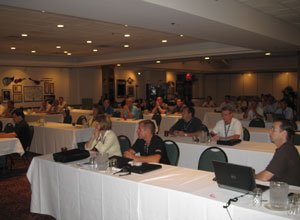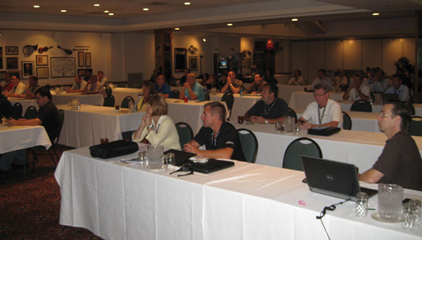
|
|
Hot topics at this year’s DICE Users Group Conference included automated PSAP communications and mobile applications and capabilities. PHOTO COURTESY OF DICE |
DICE Corp., Bay City, Mich., held its 9th annual Users Group Conference (DUG’12) in Frankenmuth, Mich., August 6-8. Among the usual array of product enhancements and updates, this year’s conference focused on a few hot industry topics, as well as peer-to-peer discussions.
Discussion topics at the conference this year included automated PSAP communications and mobile capabilities for central stations with DICE’s Matrix Monitoring portfolio. Last year, the ASAP to PSAP protocol used in Houston and Richmond, Va., was a big topic of discussion and that discussion continued at this year’s conference.
“A lot of talk surrounded the ASAP to PSAP program,” said John Williams, central station manager at Alarmco Inc., Las Vegas. The communications protocol allows for automated communications to first responders or public safety answering points (PSAPs) directly from the central station. CSAA and cities are working together to roll out similar programs across the U.S., but adoption is slower than many in the industry would like. Sessions at this year’s conference focused on DICE’s enhancements to its automated PSAP communication software module, as well as pilot program demonstration and experiences from central stations that have implemented the program. “So many of us would love to do this—it would be an enormous help to us as a company if we could blast out information electronically. It’s invaluable,” Williams added.
Mark McCall, director of information technology and facility security officer at United Central Control, San Antonio, Texas, said he spent quite a bit of time talking about ASAP to PSAP and his company’s pilot implementation in 2011. “Many of us in the industry are ready to go, but there are a lot of working parts to coordinate these programs with the PSAPs,” McCall explained. “For us, being live with this in Houston has been a very beneficial tool; it’s so good, it’s hard to measure. There was definitely a lot of discussion and a lot of interest about this again this year.”
In addition, DICE’s Matrix suite, which works with its OpenCore platform, was a buzz-worthy topic of discussion, and demonstrations were a big part of the agenda. Users and DICE employees showed off Matrix capabilities on an array of devices, such as Nooks, iPads, laptops and smartphones.
“Our clients really responded to the various training sessions that operated as an open forum,” said Melissa Courville, head of marketing and communications, DICE Corp. “This allowed attendees to obtain a detailed view of what their software can do. It was beneficial for users to be able to talk to those companies that have piloted the new programs to see how it was working for them with actual statistic pulls on efficiency boosting and ROI.”
Aside from demonstrations and educational sessions, helping fuel an atmosphere of collaboration was DICE’s structure of committees, subcommittees and peer presentations. Last year, the DICE Users Group was restructured from one larger group to form 11 smaller subcommittees. Committees have quarterly telephone conferences to discuss the products, as well as what enhancements and capabilities they would like to see. They vote on their priorities and upgrades are announced and demonstrated at the yearly conference.
The new structure has allowed for directed development work that was lacking in the past, according to Phil DuPont, director of operations at DICE Corp. “With the subcommittees, we’ve really been able to focus on specific aspects of products that people find important, and it provides a way for users to hone in on what they want to get out of the conferences by being able to follow the specific developments they’re interested in,” he said.
Williams, who is a member of three committees, said that the regular interaction with industry peers has been well worth the extra time. “I appreciate the opportunity to be on these committees, since as a smaller company, it’s so important to get our voice heard and also share ideas and help each other with the challenges that all of us in the industry are facing,” Williams said.
Another key focus this year was on best practices — something attendees cited as most beneficial to them. In the past, best practices were always a part of the last day of the conference, however, because of popular demand, they were spread out to include multiple sessions on each day so attendees could gain even more knowledge from their peers, according to Courville.
“Best practices have always been something users have pled with us to never remove, and so this year we did them all throughout the conference in several sessions,” Courville said. “Even if they don’t directly affect the software, these discussions cultivate an environment for solutions.”
According to McCall, being able to speak face-to-face with peers and vendors he deals with regularly over the phone is invaluable. “There was a good deal of best practices this year, which was really helpful, but the biggest benefit for me is the offline discussions with central stations that have similar issues that we have, and also the sponsors and manufacturers,” McCall said. “Being able to have one-on-one conversations with these people is so valuable, it just enhances what we learn in the educational sessions.”
Next year, DICE plans to take that atmosphere of collaboration one step further by rotating locations of its yearly conferences from close to its headquarters to user’s cities so attendees can visit pilot programs and get first-hand experience of how their peers have implemented different applications. DICE will kick off the new format with next year’s conference, which will be held August 5-7 in Grand Rapids, Mich., near Engineered Protection Systems Inc.’s headquarters, the peer host for DUG’13.

